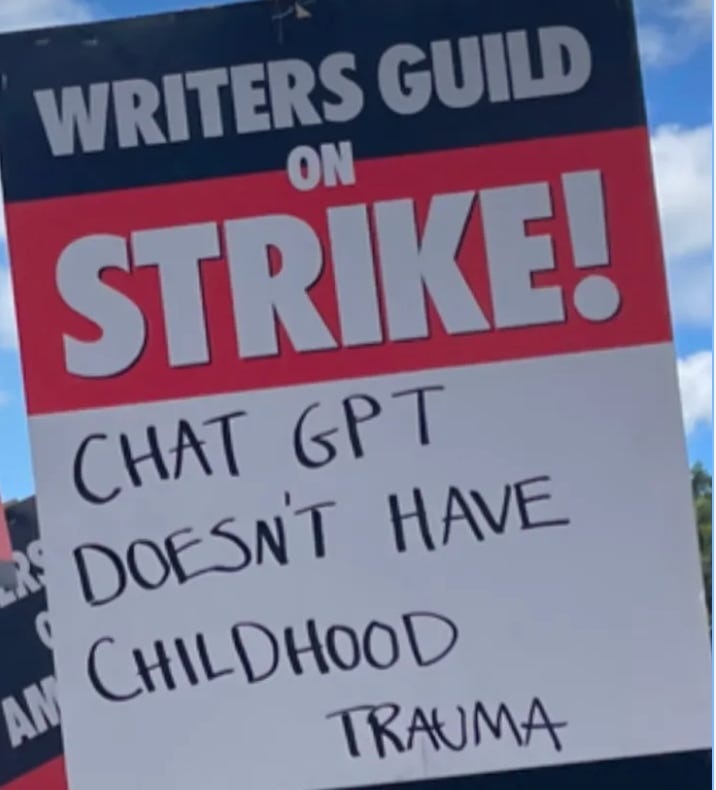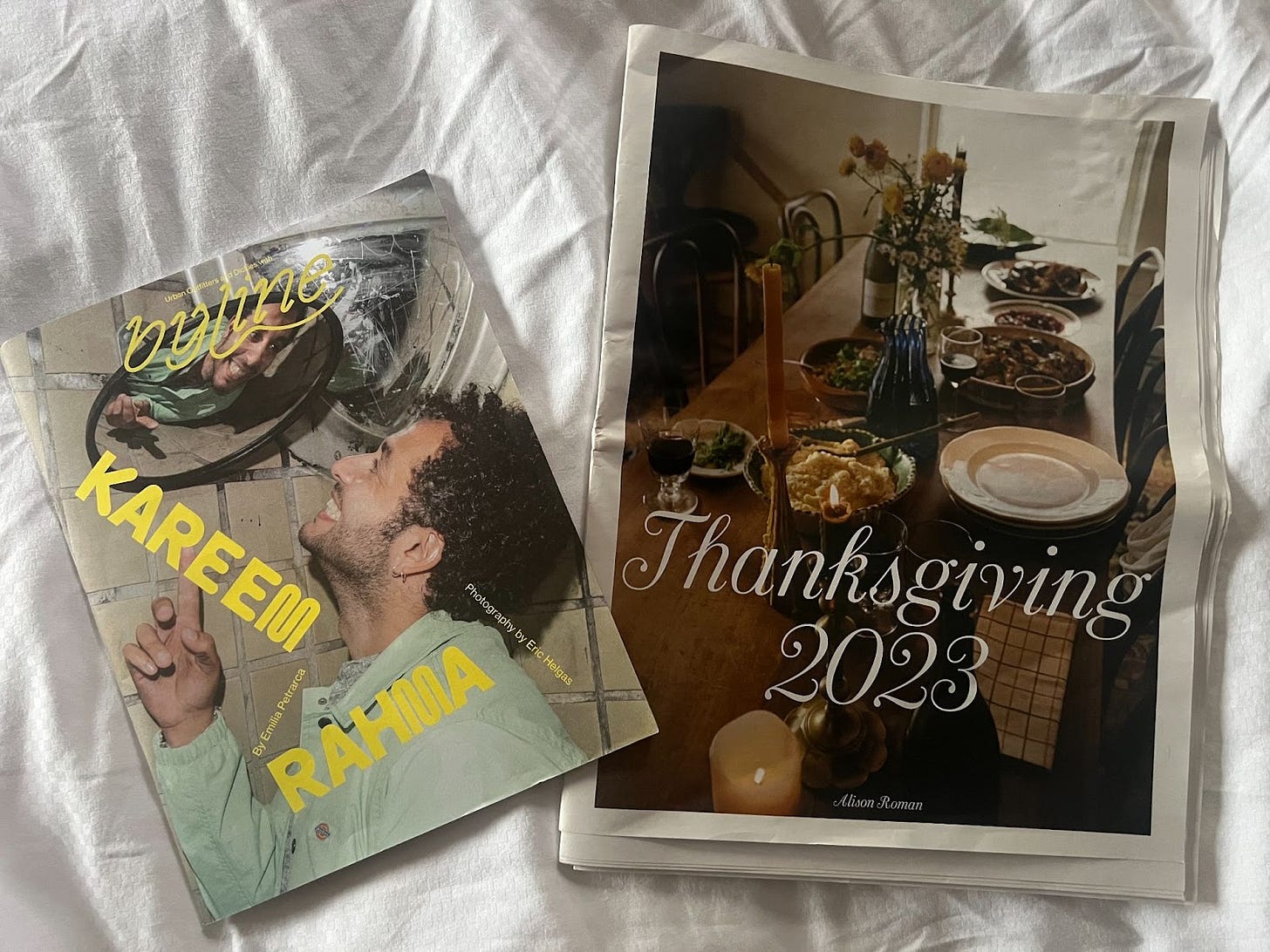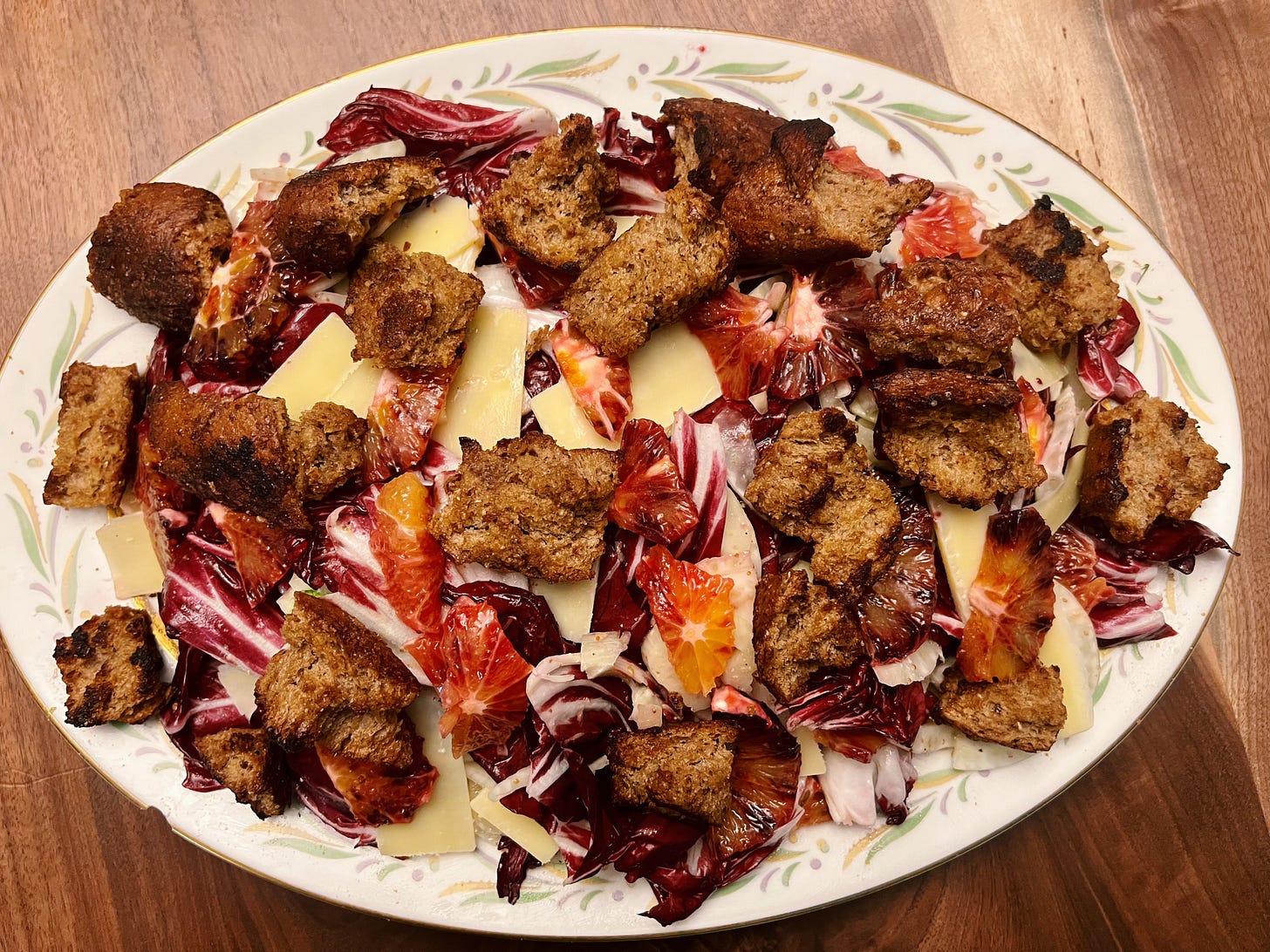"If we must": pt. 1 of an ambivalent guide to AI + content strategy
The AI revolution is here and it's kinda boring. Plus zines, advent calendar cash grabs, Celtic holidays, and tuna melts for breakfast.
Hope you all had a great Thanksgiving, and greetings from an inbox that is no doubt bursting with emails trying to sell you things. This email was written by me, Colette Keane. If it was forwarded to you, you can sign up here for more.
Let’s be honest: a lot of us feel ambivalent about this whole AI and content thing. To be fair, our relationship started off on the wrong foot. We were told the robots would make it so seniors wouldn’t have to spend the Christmas holidays working 14 hour shifts in Amazon warehouses. Instead, artificial intelligence arrived exactly as expected, as a trope borrowed from sci-fi and aimed directly at liberal arts majors.
I think some of the immediate feelings of doom and fear have faded as our institutions have begun to indicate that, no, they are not just going to let this unfold organically. What I’m hearing and sensing instead is a lot of begrudging acceptance. We are drowning in discourse about how AI will change our jobs and getting sold bold new futures from vendors that deliver on maybe a third of what they say they can. At this point, it doesn’t feel like a breakthrough, it feels like another task added to our to-do list.
There are some people who are genuinely curious and psyched about text-generating AI (who aren’t also hawking something), and I think that’s great. Their enthusiasm is charming, and I envy their motivation to experiment. That’s not me. I’m not a hater, I’m not a techno-optimist, I’m just ambivalent and a little bit bored.
But I also believe in learning and adapting, so I’ve spent the past few months reading and researching and experimenting, and since I’ve seen so many people looking for information they can use right now and not when AI models eventually reach maturity, I thought I’d share what I’ve learned and what I’m recommending at this point in time for the rest of you who are AI-ambivalent.
There is more than enough discourse on AI, and many people better suited to it than I. My goal instead is practicality: how should you fit AI into your process and team structure, what tools work best for what, and how should the presence of AI impact strategic decisions you make about different formats and distribution strategies for this next year. For now, I’m only focusing on text-generating AI (though I’m most interested in other applications). I’ll break this into two parts: this first issue will cover how I think AI will impact broader strategy and channel investments, while the second issue will include a pretty detailed audit and comparison of the available text-generating tools on the market, as well as recommendations for how to fit them into your process.
My biggest takeaways:
Most of us aren’t going anywhere. LLMs create mathematically average stories and content. They’re great for leveling bad writers up to that mathematical average, and for doing things that succeed on averages. But mathematical averages are also boring, and our jobs aren’t really about creating mathematically average writing. Journalists uncover the truth, and marketers intrigue people with alchemic juxtapositions of the familiar and unexpected. Mathematical averages can’t do either of these things, or at least not particularly well.
AI will make you faster, but it won’t give you a direction. Speed isn’t a virtue, but it is a competitive advantage. I don’t think speed is the biggest issue in the industry at the moment. It’s inertia. To summarize the point made so eloquently by Ryan Consbruck, we’re confusing optimization and progress.
Own your audience. The most important thing you can do right now is have a direct relationship with your audience. This has been true for years and has become increasingly important with the changes to third party tracking and algorithmic meddling, but the arrival of AI feels like a complete dice roll on content distribution. There's a very good chance that reaching and acquiring new audiences is about to become exponentially more difficult or expensive. You should prioritize above all else guarding your relationship with readers and potential customers by owning the means of communication, and create strategies that convert platformed audiences (on TikTok, YouTube, podcasts, etc) to owned channels.
Quality > Scale. The pendulum of competitive advantage is swinging from volume to quality as AI makes scaled production possible for anyone. There’s a big opening for small, nimble, and creative teams to succeed.
How AI changes the the role of writers:
Decent writing is officially table stakes, which means quality just became so much more important.
My favorite sign from the WGA protests said it best: "ChatGPT doesn't have childhood trauma." Having a clear, unique, and compelling point of view based on your personal experience has always been important, but now it's essential.
ChatGPT is mid at tone, and being mid at tone is exactly the same as being terrible at tone. Writers’ and marketers’ jobs are now to deeply understand tone and audience, and the specificity and nuance required by variations in them.
There's already been a shift to spokesperson and creator-led editorial, but AI's going to make that shift more pronounced. Audiences will crave personal perspectives and trust people that sound like people. Being able to write on behalf of and build content strategies for portfolios of spokespeople will be critical (this is something I’ll cover in an upcoming newsletter). I worry about traditional journalists’ ability to navigate this changing preference and balance it with the imperative to report facts in a straightforward way that’s unclouded by personal opinion.
Curation has become its own form of taste-making and expertise. We’re drowning in content, and while there are AI tools that do this for you, people seem to pretty clearly prefer trusted experts to do it for them.
Predictions for how AI impacts different strategies:
📈 Episodic (podcasts, newsletters, recurring YouTube shows, and weeklies/quarterlies that are published on regular intervals): franchises that follow this model have been some of the most successful over the past five years because they create a habit with readers and viewers, and side-step the futility of trying to break through the wall of always-on attention whenever they have something to say. I think episodic content will continue to grow and succeed because it's inherently creator and relationship-focused, and I’m particularly intrigued by the success of new publications like Byline and AirMail that have built their entire publishing model around this kind of cadence.
📉 Programmatic SEO: competing at programmatic SEO has always been a matter of scale and optimizing for algorithms, which means AI just made it equally easy for everyone. I think people will still use search to research specific solutions and products, so you should definitely take advantage of the AI tools available to go after keywords directly related to purchase behavior, but I think people are losing trust in non-branded search for information (I add publication names into most general searches now to avoid the SEO slop) and starting to just go directly to TikTok for explainers and reviews. Since Google officially opened the floodgates for AI-generated content, my bet is that strategies built entirely or mostly around SEO will start to fail within the next year. The picture is a bit murkier for media publications, but I think it’s most likely that advantages will continue to accrue to big, brand name publications people trust on specific topics. Getting people to convert beyond that first click will get harder, though. Quite a few brands and media publications I’ve spoken with have already spent the year struggling to convert Google traffic from topical articles to customers or subscribers.
✅ Campaign-based: this is usually long-form and/or partnership-driven, and follows business cycles rather than consumer attention cycles. It's getting harder to break through with campaign-based content, but I think this will evolve. I think brands will succeed by layering more and different types of media buys and distribution tactics – particularly brand investments and creator partnerships – alongside campaign content. This is true for both B2B and consumer brands.
⁉️ Virality: The early age of the current internet era was built on virality (think Buzzfeed headlines) because Facebook was the primary distribution channel. Search changed this focus, but with TikTok on the rise and search a deluge, I’ve noticed a lot of brands trying to engineer viral hits again. This version of virality feels different than the Buzzfeed era, though. It feels like a runaway train, and like consumers are the only ones capable of directing it. I’m not convinced brands can successfully manufacture virality these days, though a lot have been trying via collaborations and partnerships.
Even if it is manufacturable, I’m not convinced virality is good for business. It’s certainly not good for media businesses that monetize in any way besides digital ad impressions; the people who subscribe and pay are repeat, loyal readers. But I think it’s arguably not good business for the consumer brands chasing it, either. Viral TikToks sell out products, but it seems like they’re just driving sampling, not repeat purchases, while snarling up supply chains and making it nearly impossible to do accurate sales forecasting. A business with a lot of sampling but low repeat consumption and mismanaged inventory and supply chain is not a good business.
If you’re in B2B and you’re talking about virality as your goal, just no. That’s your ego talking.
🤩 Conversational and choose-your-own-adventures delivered by custom GPT: OpenAI just launched custom GPTs, which will allow anyone to create a version of ChatGPT tailored to whatever they want it to. THIS is where generative AI starts to excite me. These are a no-brainer for customer service, obviously, but I also think they’re a breakthrough for learning and choose-your-own adventure content and storytelling. You’ll be able to teach and inform people in conversational interfaces that break up large chunks of content and allow people to engage directly with it. Quartz had a “chatbot” news app way back in 2015 that delivered funny, insightful summaries of the day’s news via a conversational messaging interface scripted by writers, and people loved it. Could you create storytelling experiences that replicate the world-building and self-guided exploration of video games, but experienced through the conversational, choose-your-own adventure interface of a custom GPT? I want to do a whole separate newsletter on how to strategize, design, and write conversational stories and content, because I think the core of the content design, world-building, conversational scripting, and tone development will need to be either done or edited by people as GPTs become the distribution tool.
Who wins next year:
Brand teams; brands and media publications that build editorial strategies that center distinctive individual voices, creators, and spokespeople (or partner with independent ones)
Who loses next year:
SEO-driven organizations and growth strategies; entry-level copywriters and sales people 😓
Cool idea up for grabs
Zines and limited-edition newspapers from small digital publishers and creators are so hot right now! I picked up Byline’s and Alison Roman’s since the distribution locations were in a tight radius around my apartment, but I also noticed similar pop-up print projects from Dirt and the satirical dating and interior design Substack Love and Other Rugs. I love this! I’ve been recommending clients with strong digital editorial brands consider the occasional supplementary, design-forward print edition this year as a way to pretty nimbly transform a content program into a brand moment. Sponsors also love it. The best executions do two things:
Focus on designs that are eye-catching, feel unique to print, and demand to be shared on Instagram
Make distribution itself an experience, whether via an event or retail and partner integration
Alison nailed the brief on both of these. Her Thanksgiving issue is beautiful and feels uniquely designed to be tucked into luggage and then scattered across a dining room table while cooking multiple recipes simultaneously. There’s even a takeaway shopping list and cooking timeline I can imagine tacking to my fridge with a magnet. And by distributing it at her favorite grocers and retailers, she created a scavenger hunt for her followers that they proceeded to share on Instagram.
I think there’s an opportunity for more business-focused readers and publications, too. I noticed copies of speakers’ books and nicely designed print copies of reports got snapped up in the first hour at Charter’s conference last month, with attendees lining up to ask for where they could get more. Should you be interested in getting involved in this trend but short on inspiration, Brooklyn Museum has a whole exhibit on artist’s zines on display until March.
This week in cash grabs
Has anyone else noticed that the advent calendar has become an ARPU cash grab? I’m pro bundling as a way to boost ARPU during a time of year when acquisition costs are crazy high and consumers expect discounts. It’s clever! And a good opportunity for product storytelling and partnerships (see: Big Night). But as someone who was raised Catholic, it’s a weird foray into religious Christmas for brands that dare not say “Merry Christmas” vs “Happy Holidays” to sling luxury face cream, beef jerky, and jam countdowns to Jesus’s birth. (Might still snag the Net-a-Porter one, though.)
Rants, raves, and recommendations
My favorite winter salad. Brightens up any rich, heavy meal. Toss some torn up pieces of bread in a mix of honey, dijon, olive oil, salt, and pepper, and toast in the oven until crunchy. Tear up a head of radicchio and thinly slice a fennel bulb. Slice two oranges (I like to use one cara cara and one blood orange for color, but this doesn’t actually matter) into bite-sized pieces, and thinly slice as much comté or manchego as your heart desires. Toss all of this together with a dressing made of more honey, olive oil, salt, pepper, and dijon (I like a mix of coarse and smooth, but whichever you have handy works). Enjoy!
If you’re one of the many startups in the middle of attempting a raise right now: 1) godspeed and good luck 2) I liked this incredibly simple and clear outline for pitch decks.
People are feeling the Celtic spirit for the holidays. Hillhouse debuted their tartan-heavy holiday collection against a dramatic Scottish Highland backdrop, I’m obsessed with the buddy trip to Ballymaloe J. Crew facilitated for theirs, and the boygenius cover of “The Parting Glass” is the tear jerker we all needed this holiday season. Real ones know The Pogues did it first.
Tuna melts are a perfect breakfast food, and I have been consuming them almost weekly at Agi’s Counter. They have all of the same components as a white fish sandwich on a bagel, and if that sounds gross to you, you need to find a better bagel place.
Have a great week, everyone!




